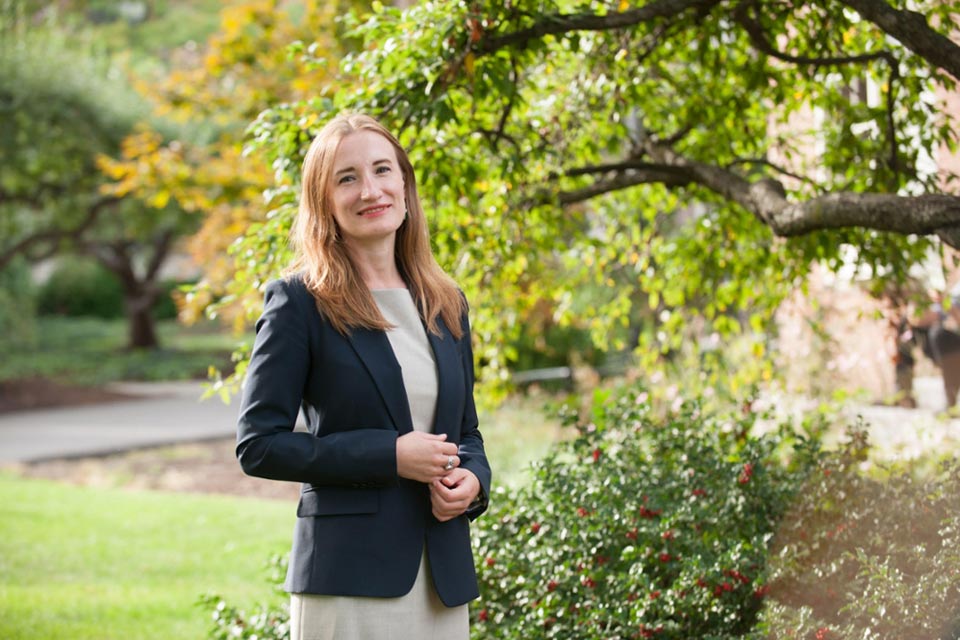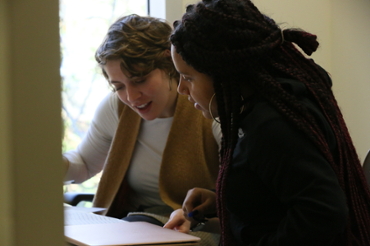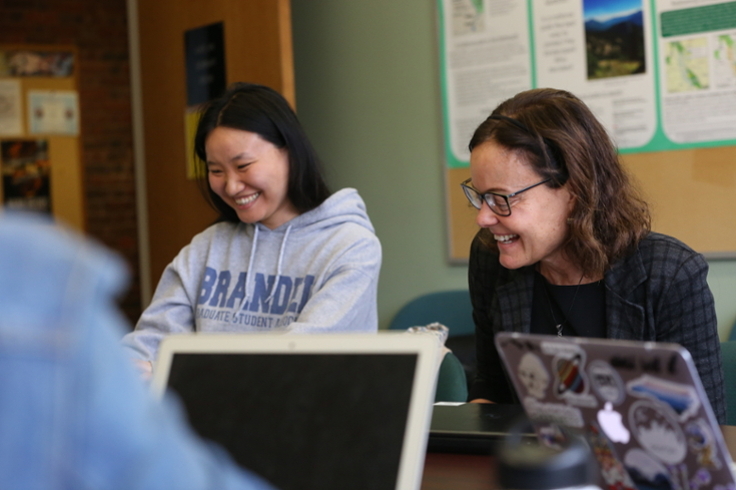Ieva Jusionyte MA'07, PhD'12 Discusses Her Career in Ethnographic Research

Photo Credit: Brown Dog Studios
April 18, 2017
By Simon Goodacre | Graduate School of Arts and Sciences
Ieva Jusionyte MA'07, PhD'12 came to Brandeis from Lithuania in 2006. She is now an Assistant Professor of Anthropology and Social Studies at Harvard University, where she studies the implications of border policies in Latin America. Her first book, “Savage Frontier: Making News and Security on the Argentine Border,” documented the lives of journalists on the "Triple Froniter" between Argentina, Brazil and Paraguay. Her second book, “Threshold: Emergency and Rescue on the U.S.-Mexico Border,” will investigate the experience of first responders working along the border between Mexico and the United States. Dr. Jusionyte recently shared some insights from her scholarship with us and provided recommendations for students considering careers in ethnographic research and Anthropology.
Coming from Lithuania, what first attracted you to Brandeis?
I came to Brandeis on a Fulbright Fellowship for my Master’s degree in Anthropology. The Anthropology Department was strong in my areas of interest, and the faculty were very welcoming, which made Brandeis one of my top choices among all the universities in the U.S.
What first interested you about Latin America as an area of study?
My interest in Latin America first emerged and developed through literature. I remember reading Jules Verne, later Jorge Luis Borges, and imagining a region so different and so far away from my home. Sitting in my room on the outskirts of Vilnius, wrapped up in a wool blanket, I was daydreaming about adventures in the Amazon. Later, when I began my graduate studies in anthropology at Brandeis, this fascination found more solid ground in ethnography and history. After my first trip to Chile and Argentina, I knew that this was indeed a region where I wanted to spend more time, getting to know its ways of life. People often wonder why a Lithuanian is studying Latin America. There are many answers to this question, but the most important one is that I value the possibilities opened up through traverse, or diagonal, engagement between parts of the world that have different experiences of political and economic marginalization: as a Lithuanian, who spent my early years growing up in a country occupied by the Soviet Union, I appreciate learning from communities that have been subjected to other forms of structural violence (right-wing military rule, neoliberalism). Instead of impeding cross-cultural understanding, my unusual background (which sets me apart from many other scholars of Latin America here in the U.S.), has helped me relate to the people I work with in Argentina and now in Mexico, as well as in other countries across the region.
Your first book, "Savage Frontier: Making News and Security on the Argentine Border," analyzes the border area between Argentina, Brazil, and Paraguay. Can you describe the situation in that region and what you uncovered in your research? Why did you select journalists a focus of your fieldwork?
During my last year in college (I was studying international relations and political science) I was working as a journalist for a digital news daily in Vilnius, Lithuania. I became intrigued by the role that news media play in statecraft. On the one hand, it is often assumed that the media works as a propaganda machine, circulating views of the world that benefit political and economic elites. On the other hand, we see how the media can also provide the checks-and-balances, keeping the government accountable to the people. These are two broad frameworks that help us understand the relationship between media and the state. But they are models. They fail to account for the complexity of practices that underlie news production and circulation.
When I started my graduate studies, I had to choose a research topic. It was then that I discovered the so-called “triple frontier.” Global and national press has been depicting the tri-border area where Argentina, Brazil, and Paraguay meet as a haven of organized crime: drug trafficking, human smuggling, document forging, contraband. It has been portrayed as a dangerous, lawless frontier. I sought to understand how news production in this vilified border region intersects with security policies and practices. Unlike political scientists who rely on models and surveys (top-down approach), anthropologists privilege a bottom-up perspective on social issues, so in order to find answers to my research questions I conducted ethnographic fieldwork with local journalists in Puerto Iguazú, a small border town in Argentina, separated by rivers from Brazil, to the north, and Paraguay, to the west. How do local journalists, who live in this allegedly violent and crime-ridden area, decide what is newsworthy in a place where everybody knows everybody? What activities that the government defines as criminal do they cover and which do they avoid addressing in public, and why? These are some of the questions that guided my research. I accompanied news reporters on the daily news beat: attended public events and press conferences, sat in on radio and television shows, and spent a lot of time criss-crossing the town on foot. Having a background in journalism, I also wrote news pieces for a local paper and produced an investigative television series, which addressed such diverse topics as military conscription, waste recycling, and illegal adoptions.
Based on this immersive research, my first book, “Savage Frontier: Making News and Security on the Argentine Border,” documents how local media in the tri-border region challenge ongoing criminalization and militarization of the area to make their community more secure. I learnt that for border residents security is embedded in their social and economic realities, and that news production is locally disputed and tactical. It depends on journalists' encounters with violent crime and memories of state terror during the last military dictatorship. Concerned with harmful socioeconomic consequences of exposing illegalized yet legitimate activities – from contraband like food and electronics to illegal adoptions – reporters protect parts of local knowledge as public secrets, thus allowing the informal cross-border economy to persist, mitigating social vulnerabilities created by a patchy presence of the state in this territorial periphery.
Next year, you will publish a book about first responders on the U.S.-Mexico border. Why did you transition to this project?
The border with Mexico has always fascinated me because of its symbolic place and rhetorical power in the U.S. national imagination. In the beginning of my doctoral studies at Brandeis, I was planning to conduct research with journalists in towns along the U.S.-Mexico border, but that year (it was 2007) the newly elected Mexican President Felipe Calderón dispatched the country’s security forces to confront organized crime groups, and Chihuahua, Sonora, Tamaulipas and other states south of the international boundary became even more dangerous for journalists, especially reporters who covered crime. I had to find another border, which was safer but still allowed me to ask my research questions – that’s how I discovered the tri-border area between Argentina, Brazil, and Paraguay.
When in 2014 I began thinking about the new project, the situation on the U.S.-Mexico border was slightly better. I decided to focus on emergency responders because they see firsthand the effects of national security policies on the wellbeing of local communities. In the border towns on both sides of the international boundary, firefighters have always worked together: Mexicans come over to the U.S. to help fight large fires; Americans cross into Mexico to provide training and equipment, or to supply water. They say that the border does not exist between them. Yet these firefighters, most of whom are now certified as EMTs or paramedics, are also the ones who rescue unauthorized migrants that fall of the border wall and injure their legs or those who get lost in the desert and suffer from dehydration. Since 9/11, fire departments have been increasingly incorporated into national preparedness and homeland security systems, and now emergency responders on the U.S.-Mexico border must learn to navigate the complex political and legal landscape, where priorities set by the “war on drugs, “war on terror,” and what appears to be a “war on migration” have overshadowed the concerns of local communities who see security as firmly grounded in binational cooperation, not in the construction of walls.
This project is a continuation of my scholarly interest in borders and security from an ethnographic perspective. But it also draws on my personal experience and my belonging to the emergency responder community: I have been an EMT, a paramedic, and a wildland firefighter, and during fieldwork on the U.S.-Mexico border I volunteered as a firefighter in a local fire department and as a medical professional at an aid center for migrants. Although the book, “Threshold: Emergency and Rescue on the U.S.-Mexico Border,” focuses on the experiences of firefighters and emergency managers in southern Arizona and northern Sonora, my own story is inevitably palpable in the narrative.
How is the situation on the Arizona-Sonora border different from the Triple Frontier?
Because of what borders do – they mark the formal limits of state sovereignty, carving out separate legal domains – the very presence of an international boundary precipitates certain practices, such as smuggling. Either goods are cheaper on one side of the border than on the other, or there are moral-legal ideologies that prohibit certain commodities in one country but not in the other, these discrepancies in rules create incentives for profiting from their subversion. Both the tri-border region between Argentina, Brazil, and Paraguay, and the U.S.-Mexico border have extensive contraband economies, which fluctuate over time. They are both crossed by active drug trafficking and money laundering routes. However, because of sharp price differences between Paraguay and Argentina, petty smuggling of common household goods, produce, or small electronics, is more popular in the tri-border area than it currently is on Sonora-Arizona border. On the other hand, regional economic dynamics, U.S. political interventions, and geographic proximity, among other factors, have for decades contributed to larger numbers of unauthorized migrants crossing the U.S.-Mexico border. Although human smuggling also exists in the tri-border area (intermixed with child and sex trafficking), there is no comparable historic pattern of labor migration that characterizes U.S.-Mexico borderlands and the relationship between the two countries. The U.S.-Mexico border has also been more violent, which is primarily a consequence of the “war on drugs” in the U.S. and in Mexico. There is more competition between rival cartels fighting for trafficking routes to the most lucrative market for illicit drugs – the U.S. In the tri-border area, drug trafficking is interlaced with local politics but factional skirmishes between organized crime groups are rare and, at least for now, there is relative calm.
You are currently researching the history of firearms in Mexico. What is a "biography of the gun," and what do you hope to achieve with this project?
I am interested in documenting how firearms move between regimes of knowledge and power: political, legal, economic, medical, and scientific. For that matter, my new project on the social biography of the gun in Mexico will trace the steps from the sites of production to the sites of destruction. Unlike in the U.S., civilians in Mexico are generally not allowed to own weapons. This ethnographic pursuit will require constructing a narrative that stitches together gun shows and pawn shops in the U.S. to the crime scenes, emergency rooms, morgues, and ballistic forensics labs in Mexico. I am at the very beginning of this research, so it is too early to tell what its broader implications will be.
Do you plan to continue studying border violence in the future? Are there any universal takeaways from your research?
Absolutely! I don’t think that, as an anthropologist who has spent so many years working in the borderlands, I could ever disentangle my scholarship from those regions and the lives of the people I met there. The question of border violence is important, not because borders are particularly violent places, but because, on the one hand, the very existence of borders produces some forms of violence (shootouts between rival drug trafficking groups or sexual assaults of women migrants in remote desert areas are just the most obvious examples; there are also pernicious structural dimensions that make some people disproportionately vulnerable to suffering), while, on the other hand, the construction and enforcement of borders (such as the building of new walls) is often justified by the rhetoric of violence coming from abroad, which the borders would allegedly stop. This discursive coupling of “borders” and “violence” is a powerful and effective political strategy, but, as anthropologists and other social scientists have demonstrated, this relationship cannot be taken for granted. My current work with emergency responders is but one example. While political rhetoric portrays the U.S.-Mexico border as a potential source of threats to the national economy and society, the livelihood and security of local communities on both sides of the international boundary depend on cooperation, not on confrontation, between public officials, business owners, teachers, doctors, firefighters. Everyday life on the border unfolds on a binational scale. At least in the communities where I have worked, violence – both direct and indirect – has most often been a result of federal policies that are misaligned with local realities.
Do you have any recommendations for students who are interested in pursuing an academic career in anthropology and ethnography?
Anthropology provides us with crucial analytic and methodological tools to understand the most perplexing of social issues. It does not seem that there will soon be a shortage of difficult topics that ethnographers are particularly apt at examining, whether globally or locally, whether through scholarly publications, policy-making, or direct community engagement. I strongly recommend anyone interested in this discipline to try it out: once you begin doing fieldwork, once you establish meaningful relationships with the people who are your research partners as much as they are your study participants, once you see how your findings not only provide a new perspective on the subject, but how they can be used to create novel solutions and promote social justice, I doubt that you would ever be able to quit. Anthropology is more than an academic discipline. It is a way of being in the world that is both critical and constructive, both and aware of profound social inequalities and attentive to its rich cultural diversity.






